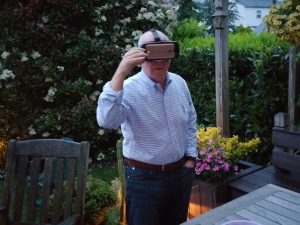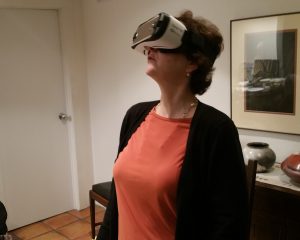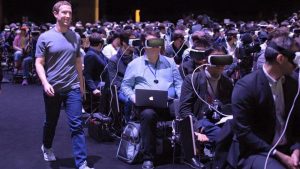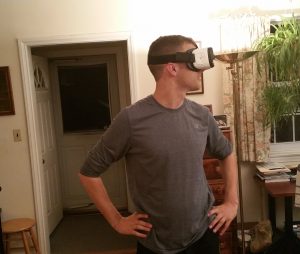I recently wrote the following article on virtual reality, which is appearing in Psychotherapy Networker’s Nov/Dec 2016 edition.
Whoa, what’s going on here? Where am I? What is this?” Joe exclaimed. “Where are my hands and my feet? Wow, this is fantastic!” Friends since our teenage years, I knew Joe had a tendency to be enthusiastic, but this reaction was really something. I’d given him options: Caribbean sunsets, the Alaskan shore, even a tour of Paris, but he chose to explore the stark and awe-inspiring American Southwest. For the next few moments, he stood in my living room, looking, laughing, and vocalizing sounds of amazement as he took in the different scenes. Of the 50 or so friends, coworkers, and clients whom I’ve watched try on my virtual reality (VR) gear and step into one of the 360-degree photos, Joe was the most effusive. Still, the others would agree that their introduction to VR was quite a memorable experience.

Of course, VR has been around since the 1980s, when Jaron Lanier, one of its initial theoreticians and developers, coined the term. VR sets have been used in therapeutic research for treatment of phobias since the mid-1990s, but they’ve only now started to enter the consumer market. Why? Well, it’s largely due to cell phones becoming so ubiquitous and inexpensive. With their high-resolution screens, small built-in cameras, and motion detectors, the production of billions of cellphone devices dramatically reduced the cost of the key components required for VR equipment. In fact, Lanier estimates that back in 1990, it would’ve cost a million dollars to buy a VR set that could match what even low-end products can offer today.
That’s a million bucks for the equivalent of my $100 Samsung VR Gear headset and $700 phone. Even better, I actually got the headset for free as part of the package for preordering my Galaxy 7. Talk about a deal! Samsung produced this fairly inexpensive set through a partnership with Oculus, the company launched from a 2012 Kickstarter campaign by Palmer Luckey, a former University of Southern California (USC) researcher. Two years later, the startup was bought by Facebook for $2 billion, and in April of this year, accompanied with great fanfare in the tech world, it released the Oculus Rift headset for $599. While the Facebook purchase gave Oculus loads of press, there’s a lot of competition in this emerging market. Google Cardboard, HTC’s Vive, and Sony’s PlayStation are just a few of the emerging products vying for consumer attention. With major film and gaming companies working to develop VR content, it’s easy to understand why the market is predicted to top $80 billion within 10 years.
Watching people’s reactions when they try on VR headsets for the first time reminds me of the stories about audience reactions at the dawn of the movie era. Legend has it that mayhem broke out at the theater in 1896 when the Lumière brothers presented their one-minute documentary, “Arrival of a Train at La Ciotat.” Incredibly basic by current standards, the film simply showed a train coming into a station from the point of view of someone standing right along the tracks. But never having ever seen anything like it before, people jumped out of their seats, terrified that they were about to get run over. Of course, as years have passed, we’ve become accustomed to the marvels of film techniques, and more and more able to maintain some sense of distance, mindful that we’re not actually in the film. VR, on the other hand, challenges some of our physical and emotional boundaries, altering our immediate experience of what’s real and blurring our sense of being separate from what we’re watching.
Put on your VR goggles and headphones and you enter a new environment, experienced from a first-person, 360-degree perspective. Like real life, when you turn your head to the right or look up, the sights you see and sounds you hear are different than when you look down or turn toward your left. While you know you’re wearing goggles and headphones, you feel as if you’ve been transported into some other world. It’s immediate and immersive. Whether it’s the center of Beijing, the top of the Matterhorn, the bottom of an animated sea, or alongside refugees fleeing Syria, you experience the moment as if you’re there. And while the popular use of VR has so far been relatively limited, researchers have already been tapping into this powerful sense of immersion to pioneer various types of VR-based therapies.
VR in the Therapy Room
Since the mid-1990s, Virtually Better Inc., an Atlanta-based company, has used VR exposure therapy to treat a variety of phobias. While its initial setups required extensive and expensive hardware, it’s recently begun recoding its software to run on iPhones, allowing me the opportunity to test out Fear of Flying and Fear of Storms, two of the most popular modules it sells to therapists looking to incorporate this technology into their practice.
First, the iPhone is placed within a headset worn by the client, while the therapist views the control panel on a computer. As the program starts up, the client is placed within an animated scene—for example, standing by the airport gate during preboarding. In addition to visual stimuli, the therapist can add sound effects such as background chatter, airport announcements, and other ambient sounds to enhance the simulation. Clients use a handheld device to control movement; they can walk down the boarding ramp to enter the plane or remain at the gate until they feel prepared, which might take several sessions. Once seated in the plane, they can no longer use the controller to move around, but must remain seemingly strapped in as they prepare to fly. As with other types of exposure therapies, clinicians will periodically check in with clients and ask them to rate their level of distress, suggest strategies to reduce anxiety, and encourage them to proceed. Clients can experience taxiing down the runway, liftoff, flight (including sounds of turbulence), and landing. It’s quite a ride!
The Virtually Better website includes abundant references to studies that have demonstrated VR exposure to be as or more effective than imaginary exposure for flying and other phobias. However, according to Marat Zanov, clinical training director, VR should be viewed as an extension to traditional approaches, rather than as a replacement for them. “We think of it as a nudge to one’s imagination,” he says. “In fact, the level of realism is only of secondary importance in its efficacy. Graphics don’t have to be at the gamer level in these programs because people who have specific phobias are very reactive to immersive experiences that are relevant to their particular fear. With their imaginations activated, we’re quickly able to trigger the stress reaction.”
Virtually Better has developed programs that address fears of storms, spiders, heights, and public speaking. They’ve also developed a module that can assist people dealing with substance abuse to confront common triggers. Imagine being at a virtual bar, with booze in the background and a pack of cigarettes on the counter. The company also provides support to military and VA hospitals using a highly effective VR product specifically developed to treat service personnel suffering from PTSD.
With major funding from the Department of Defense, VR programs Virtual Iraq/Afghanistan and BRAVEMIND were developed at the University of Southern California Institute of Creative Technology for work with combat vets. These programs include immersive scenarios of Middle Eastern urban, village, and road environments. Clients are presented visual stimuli through a VR head-mounted display with the imagery enhanced by directional 3D audio, vibrations, and smells. According to Skip Rizzo, USC’s lead researcher for this project, VR is the perfect vehicle to help a soldier or vet reexperience traumatic situations under safe and controlled conditions. Of course, “It’s not possible to go out and recreate the actual scene,” he says, “but the VR settings seem to be more effective than simply asking someone to imagine the situation. Besides, many of our young military personnel grew up with gaming technology and may be more comfortable with a VR approach than traditional talk therapy.”
Further developing the use of this technology as a tool to confront people’s fears, a research team led by Daniel Freeman at Oxford University recently conducted an experiment to test whether people suffering from paranoia might be helped through VR experiences. The study included 30 patients who were experiencing persecutory delusions, such as people see me as an easy target and do things to belittle me and someone intends to kill me. Through VR, they were placed in an underground train and on an elevator for a total of seven simulated journeys, with the number of virtual passengers increasing in each successive run.
The participants spent only 30 minutes in VR, but their responses in the pre- and post-testing—which included being placed in real-life situations—showed a significant improvement. This was particularly true for those whose experiences were accompanied by cognitive behavioral suggestions to do things in the VR environment that they were unable to do in real life, such as directly approaching or gazing in the direction of a stranger. Speaking to the BBC, Freeman noted, “At the heart of paranoia is the unfounded belief that people are under threat. With virtual reality we can help the person to relearn that they are safe, and when they do that, the paranoia begins to melt away.”
Not Exactly Therapy—But Therapeutic
Other clinicians and researchers have explored VR’s potential as a platform to assist children with autism learn social skills, to provide life-skill training for children or adults with cognitive disabilities, and as a learning tool for people recovering from brain injuries. Also, a VR program called SnowWorld, developed by scientists at the University of Washington, which places patients in an immersive snowy environment, has been shown to help burn victims and others receiving wound care better manage their pain. Indeed, Howard Rose, cofounder of DeepStream VR, a health-focused VR company, believes the technology has great potential for many people who experience chronic pain.
Rose believes that some of the power of VR for pain relief comes from disrupting the body map and breaking the cycle of pain that can lead to persistent suffering. His company’s new product, Glow, allows people to experience themselves being outside on a summer evening, with fireflies flickering in the background. A biosensor measures their heart rate, and as the rate slows down, reflecting a more relaxed state, their hand starts to glow and attract the fireflies. As long as they stay relaxed, the warm glow continues and they can gather the flickering lights to fill lanterns and expand the effect. “It’s one of those Oh Wow! experiences,” he says. “Although it might seem somewhat ironic, we feel this type of VR technology can enhance a person’s ability to relax and apply mindfulness techniques to ease both pain and suffering.”
Given VR’s capacity to simulate different environments, let’s imagine ourselves in a beautiful underwater world. We look at interesting plants, meet fish and other creatures, and spend time exploring various nooks and crannies. We soon recognize our movements can be controlled simply by breathing, going deeper with each breath in, moving forward as we exhale. The slow, deep breathing that best propels our journey also relieves anxiety, and we soon become deeply relaxed. That’s the idea for DEEP VR, the brainchild of Owen Harris, a game developer from Ireland.
As a young man prone to anxiety and depression, Harris found that by controlling his breath he could dramatically impact his mood. This realization, coupled with being trained to scuba dive by yoga instructors, gave him the inspiration for DEEP. However, he doesn’t advocate VR as a replacement for real-life experiences. “I see it more as a break,” he says. “Let’s say you’re having a tough day and the stress is building up. Perhaps during lunch, you set aside 30 minutes to slip into a beautiful immersive world, breathing slowly and deeply during that time. It’s rejuvenating. It recenters you and serves as a beneficial complement to daily life.”
Harris excitedly talks about one day using VR to visit Machu Picchu or kayak the fjords of Norway. “Through VR, these experiences will not only be available to the privileged few, but to anyone with access to a smartphone,” he says. And like other VR enthusiasts, Harris doesn’t believe we’ll choose to be in these new virtual environments by ourselves as much as we’ll enjoy sharing and participating in them with others. He envisions DEEP, and VR in general, as becoming an increasingly social experience.
Social VR
Harris is just one of many who are struck by VR’s social potential. Mark Zuckerberg, founder and CEO of Facebook, said in his post announcing the company’s purchase of Oculus, “This is really a new communication platform. By feeling truly present, you can share unbounded spaces and experiences with the people in your life. Imagine sharing not just moments with your friends online, but entire experiences and adventures.” Many technology pundits and venture capitalists share Zuckerberg’s enthusiasm, conceiving of it as a new way to “attend” concerts, sporting events, and classes or share fantastic settings with friends, family, and coworkers.
This possibility hasn’t been lost on the adult entertainment industry. Since the days of the early printing press, pornography has been a driver of technological advancement, and as you can imagine, the porn industry is hot about VR. Creating an immersive experience, in which the consumer is brought into an intimate setting through the eyes of a participant—a 360-degree camera placed in the boudoir, or even on a performer’s head—offers a new and powerful viewpoint through which to experience sexual encounters.
While the visual and auditory stimulation is quite compelling, the experience can be enhanced by advancements in teledildonics (technology for remote sex or, at least, remote mutual masturbation), where tactile sensations are communicated over a data link between the participants. Essentially, you’ll be able to “reach out and touch someone,” by stimulating them physically in real time, through an internet-based sex toy. It’s easy to see people becoming aroused, and perhaps even “addicted,” to this nascent platform. Will 17-year-old boys ever want to leave their rooms? Will everyone else eagerly await time to be alone in home sensory chambers, to explore this new form of sexuality and have encounters with people (known and unknown) in VR spaces? As the technology evolves, will we choose to transmit the images of our real selves or somehow merge our VR presentation with our more youthful-looking bodies? Perhaps we can take on the persona of a movie star or the shape of a mermaid? It’s hard to know what people will choose, but clearly it opens a new realm of fantasy.
Proponents of the adult industry believe VR will provide new opportunities to learn and try out different activities and perspectives. In one tech forum, a 30-something male described experiencing VR sex from the female perspective as an event that altered his attitude toward sexual aggressiveness. In fact, shifting people’s perspectives and using VR to develop greater empathy has been a key area of research at several of the leading centers studying the technology.
The Stanford Virtual Human Interaction Lab has demonstrated that experiencing something in VR can have a stronger influence on empathy than reading about the issue or watching a film. In one study, participants who experienced color blindness in VR were more determined to find resources for people who actually had this condition than those who learned about it in a classroom setting. In other experiments, young people were able to better identify with issues related to aging, such as making sure to save enough for retirement, after experiencing themselves as a senior within VR settings. Recently, a number of businesses, including the NFL, have shown interest in using the platform to help employees understand sexual harassment and racial discrimination.
Mel Slater, head of the Experimental Virtual Environments (EVENT) Lab for Neuroscience and Technology in Barcelona, describes his evolving focus from creating and understanding how VR leads to an illusory sense of location to seeing how VR might be used to “change the self, not just the place.” Slater has conducted a wide range of experiments on how people respond when virtually inhabiting a body, often quite unlike their own. He explains, “We tend to think about our bodies as being stable, only changing slowly over time as we age. However, our work in virtual reality has shown that our mind’s body representation is more of a temporary construct, which we continually reconstruct based on our sensory input. With the right type of stimulation or association, you can fairly quickly have the illusion that your body is quite different than it is. This can impact your attitudes, behaviors, and how you experience the world.”
An important concept in VR is something called embodiment, the process through which people can associate themselves with a virtual body within the VR environment that they see from a first-person perspective. It’s achieved by having them don VR glasses and body sensors while the system records their exact movements as they speak and react. These movements can then be simulated within the VR environment by an animated character, known as an avatar, that individuals experience as being themselves, even if it doesn’t look like them.
An experiment called “Freud-Me,” recently done at the EVENT Lab, explored an interesting twist on this concept. Participants (all males) were placed within a VR setting and embodied in an avatar of themselves. Next, they were embodied in a VR representation of Sigmund Freud. In what might be conceived of as the Gestalt empty-chair technique on steroids, each participant was able to enact and view himself from both sides of the role-play. The interaction began with the participant embodied in the avatar that looked like himself explaining a real problem he was facing to the Freud avatar. Then embodied as Freud, the participant was instructed to listen to and offer the best advice he could. The response was recorded, and then once again embodied in his own virtual persona, the participant listened to and watched the famous psychologist respond to his dilemma. (The vocal pitch was lowered when Freud spoke, so it sounded a bit different from the participant’s and gave it a tone of authority.) Using the asynchronicity of the exchange, an individual could choose to repeat a specific interaction or simply continue the back-and-forth exchange, along with the process of body switching until he decided to stop.
Although not clinically tested, the results were promising. It seems that having Freud respond increased both the receptivity and confidence participants felt in trying alternate strategies to meet the challenges they’d described. In a sense, the experiment created a technologically enhanced self-help technique, through which one might take an internal dialogue between different parts of the self and externalize it to more effectively help resolve a personal problem.
After this success, Slater was asked by Chris Brewin of University College London to help design an experiment to test this approach with people suffering from depression. Applying principles from Compassion Focused Therapy—which holds that depression is linked to a heightened tendency toward self-criticism, accompanied by difficulty in experiencing self-compassion—a group of healthy but highly self-critical, depressed women were placed within a VR environment and embodied in an adult avatar. They were asked to become familiar with a script of compassionate phrases that might be useful to say to someone who was upset. Upon entering the VR space, the adult woman avatar would come across a crying child and use some of the encouraging phrases she’d just rehearsed. As she spoke in a soothing and kind manner, the child would calm down and gradually stop crying. After this interaction, the woman was embodied in the child’s figure. From that position, she listened to and saw the adult avatar use her own words and movements to express compassion toward her.
Noting a positive impact for many of the participants after three weeks of treatment, Brewin explained, “Some people don’t feel they deserve compassion. They get uncomfortable if someone is kind to them and find it difficult to be kind to themselves. It was easy for the women in our experiment to express compassion toward the child, and we believe that the perspective-shifting in VR allowed them to more readily accept the compassion as well.” Encouraged by the results, researchers are currently looking to fund more extensive clinical trials.
New Ethical Considerations
Slater’s work on perspective-shifting and “changing the self” exemplifies positive results from this technology, but he admits that negative consequences can occur. As leader of the European Union’s Virtual Embodiment and Robotic Re-Embodiment Project, he encouraged Thomas Metzinger and Michael Madary from the University of Mainz, Germany, to explore these consequences. And in their paper, “Real Virtuality: A Code of Ethical Conduct,” they offer an initial list of ethical concerns pertaining to research and personal use of VR-related technologies. Describing how VR is distinct from other forms of media, they note it can “create a situation in which the user’s entire environment is determined by the creators of the virtual world. . . . Unlike physical environments, virtual environments can be modified quickly and easily with the goal of influencing behavior.” They echo sociopolitical concerns also being raised for “new and especially powerful forms of both mental and behavioral manipulation, especially when commercial, political, religious, or governmental interests are behind the creation and maintenance of the virtual worlds.”
Beyond the more obvious political implications, as the systems become increasingly sophisticated, vast quantities of personal user data including eye movements, facial gestures, and motor responses will be collected, thereby allowing private agencies to acquire details about one’s interests and preferences in hitherto untapped ways. The authors posit that sophisticated techniques might allow marketers to manipulate consumers “by real-time feedback of their avatar’s own facial and eye movements” to sell products or produce changes in users’ mental mechanisms themselves. Furthermore, recognizing that one’s kinematics (physical movements) may be uniquely connected with one’s identity (a new type of “fingerprint”), the collection of intimate data adds a new level to the effects that technology will have on privacy-related issues.
Madary and Mettzinger also believe that VR technology will eventually change not only our general image of humanity, but our understanding of deeply entrenched notions, such as conscious experience, selfhood, and authenticity or realness. They fear that heavy use of the technology might trigger new stressors, perhaps causing an increase in people developing symptoms associated with depersonalization-derealization disorder, a condition characterized by chronic feelings or sensations of unreality. Increasing the frequency of depersonalization (in which individuals experience an unreality of the bodily self) and derealization (where individuals experience the external world as unreal) seems like a genuine possibility if people begin to spend significant time within the VR environment.
But will people actually want to spend that much time within the VR world? Recognizing both the potent and taxing nature of VR experiences, many research labs have limited VR exposure time to as little as 20 minutes or less per session. Companies producing VR equipment caution against extended use and warn consumers about side effects associated with cybersickness—a condition similar, though with somewhat different symptoms, to motion sickness. While people are unlikely to spend too much time doing something that gives them an immediate headache or makes them nauseous, improvements in the technology appear to be decreasing the percentage of people who get queasy, and comments in tech forums suggest that as users get acclimated to the intensity of the VR experience, they can tolerate longer stays.
Gazing into the Crystal Ball
Let’s circle back to the impact of VR in the therapy room and upon our profession in general. Is VR really a game changer? To date, VR’s most visible role has been in the treatment of phobias and other conditions where it’s served as an alternative or adjunct to imaginary and in-vivo modalities. However, newer applications have started to move beyond the idea of altering our sense of place to emphasize altering our sense of self. As the technology continues to improve and our clients’ interest and familiarity with it grows, the possibilities seem endless. To start, perhaps we can replace our phone and Skype calls by conducting sessions in a VR office, in a location that includes stunning beachfront property? Moving forward, skill-building and self-esteem sessions might routinely incorporate VR interactions within simulated environments as a new form of role-play. Work on family interactions might include reviewing a dinner scene recorded through 360-degree perspective, and thereby available to be explored from multiple angles. Perspective shifting through VR embodiment might even become the foundational component for a new set of therapeutic approaches.
A long time ago, before I was a therapist, I was employed in information technology and enjoyed exploring upcoming technological trends. I took pride in being able to understand the potentials of disruptive technologies—a term used describe a device or group of computer programs that have the potential radically to change an industry or area of daily interaction. I was an early internet advocate and foresaw the rise and some of the far-reaching effects of mobile smartphones. Although it’s been less than a decade since the iPhone was introduced, most would agree that the rapid adoption of this pocket computer, along with its competitors, has profoundly changed our social relations and expectations. Some of the changes, such as increased communication and access to information, were easy to predict, as they were the key selling points. Many other benefits—including apps to assist in everything from paying bills, mapping a trip, calling a cab, and tracking sleep patterns—were much more difficult to imagine. And of course, some of the negative ramifications—such as choosing text instead of direct communications to deliver important messages, feeling the “need” to interrupt in-person interactions to check social media, and the increased background anxiety of being plugged into the 24-hour news cycle—were harder to foresee. If there’s a lesson to be learned, it’s that predicting specifics about the future is a tough gig, and even skilled prognosticators are usually surprised at what actually comes to pass.
But here we are again at the dawn of another new, potentially highly disruptive technology that will profoundly influence us in ways we can only begin to conceptualize. After a history of false starts and overly optimistic timeframes, VR is finally moving into the mainstream, with low-cost consumer products becoming readily available. Most of us can stay away from VR at this point, but I wonder if by choosing to gain familiarity with it instead, we can understand and adapt to the profound societal and professional implications it’ll bring.
Recently, I decided to take a break from writing and go for a walk on a warm autumn afternoon. As I soaked in the sunlit scene around me, I recalled a quote by Bill Gates: “We always overestimate the change that will occur in the next 2 years and underestimate the change that will occur in the next 10. Don’t let yourself be lulled into inaction.” Near the end of my block, I came upon a giggling group of young teens. Walking and talking at a fast clip while staring at the camera screens of their phones, they were absorbed in Pokémon GO, the latest worldwide craze and first big augmented reality (AR) app. Unlike VR, which creates a full alternate environment, AR displays computer graphics or information in a layer over the real world.
In 10 years, will kids like these experience “reality” as a kind of continuum with unfiltered real life on one end, virtual reality on the other, and levels of augmented reality in between? Moments like these make me smile and remind me that what appears incredibly strange to us old folks will just be normal life to them. To be sure, as our technology continues to advance in the years and decades ahead, it will be harder and harder to answer the age-old question: what is reality anyway?





